The much anticipated PlayStation 5 released late last year, and promised a lot of great upgrades and advantages over the previous generation PlayStation 4; but just how many of the promises are being adequately met, and how does this compare to PCs?
The PS5’s main feature set seems to be the following:
- Ray tracing
- 4K gaming
- Up to 120 Frames Per Second (FPS)
- HDR technology
- 8K support
Ray tracing is something the gaming community should have been introduced to at around the time of Nvidia’s RTX 20 series GPU launch, which was approximately August 2018. I did a fairly in-depth write up on what ray tracing and Nvidia’s RTX cards were all about, if you want to check that out here.
Right now, turning ray tracing on for your PS5 will mean a serious frame rate drop, so it’s only advised for single player games instead of online/competitive games – this is similar to PC, but unlike on PC there’s basically no wiggle room, whereas on PC if you have decent hardware you may be able to keep ray tracing on if you wish, and still play competitively (game dependant perhaps). Ray tracing is also supported by very few games right now, both on consoles and PC for what it’s worth.
4K gaming is great for those who may already have 4K capable TVs, or if you’re in the market for a new TV, a 4K TV is practically your only option. So it’s not entirely ground-breaking or unexpected that the PS5 would support this out of the box. 4K resolution is also available in gaming and home/office grade monitors. Many of the staff (myself included) have been using 4K displays with a PC for some time now.
120 FPS gaming (or higher) is something that has been happening for many years on the PC side of things. Generally speaking, most of your everyday monitors are 60Hz (meaning a maximum of 60 FPS), but opting instead for a ‘gaming’ monitor can mean a 144Hz, 165Hz, 240Hz, or even 360Hz monitor, with the FPS to match each of those. Not surprisingly, many staff (myself included again) do have high refresh rate gaming monitors/TVs in our lives, hooked up to our PCs.
120FPS is limited to very few games on PS5 at the time of writing. We expect this to become more of the norm as time goes on, but on the PC side of things it’s very rare to see a PC locked to 60FPS still.
HDR (High-Dynamic-Range) again should be familiar to those with relatively new TVs, or those in the market for a TV. There are differing qualities of the implementation of HDR and its effectiveness on screen, but much like “4K”, HDR has become one of many marketing terms that can be thrown onto a product to increase the attractiveness of a product to those who may not quite grasp what it means. There are certainly some good TVs with great HDR, but they typically sit at the top of the price spectrum. HDR also comes on many monitors, both gaming oriented and otherwise.
8K support should probably be with an asterix. Even if you had an 8K display available to you (lucky you!), it’s widely reported that the PS5 simply does not support 8K today, instead topping out at 4K. It’s speculated that 8K support will come in future, but it’s not entirely clear on how far in the future you will have to wait. Additionally, despite supporting HDMI 2.1, it’s not currently possible to take advantage of HDMI 2.1’s Variable Refresh Rate (VRR) or Auto Low Latency Mode (ALLM). These features will require a compatible display, of course.
Introduction to the benchmark
Steve from Gamers Nexus has put out an in-depth piece on the PlayStation 5 in 120FPS mode vs. PC at 120FPS, with benchmarks and his usual attention to detail to boot.
In order to match the PS5’s hardware for the benchmarks, Gamers Nexus had to elect a CPU and GPU/graphics card to as closely as possible match the PS5’s performance. For all games the CPU was AMD’s R3 3300X which is a 4 core 8 thread processor with a base clock of 3.8GHz and a boost clock of 4.3GHz and was released May 2020 and represented the lowest end of AMD’s Ryzen 3000 series processors that did not contain an integrated GPU.
For Devil May Cry 5, the GPU was Nvidia’s GTX 1060 6GB which came out mid-2016 and was a medium tier gaming product at that time.
For DiRT 5 the GPU was Nvidia’s GTX 1080 8GB, which released in May 2016 and was a high-end model for that time.
For the Borderlands 3 benchmark the PC’s graphics card was swapped out to the Nvidia GTX 1070 Ti 8GB, which released late 2017 and represented the middle-to-high end of that generation of GPUs.
Ray tracing was turned off in all of the testing on both PC & PS5.
Steve made sure throughout the video to make it abundantly clear that they could have selected lower performing/older hardware than the above, but to try and keep things simple they aimed for recent hardware that closely matched the PS5’s performance.
To emphasise, the hardware Steve from GN has selected is fairly low end compared to what we consider for gaming PCs in our business today. And when discussing the GTX 1060 6GB, the GTX 1080, or the GTX 1070 Ti in particular, they’re no longer in circulation due to being 2 generations old.
It should be becoming clear that the PS5 then isn’t exactly pushing the boundaries of technological advances since the PS4, but instead is playing a game of catch up. Even this isn’t new(s) for consoles!
Devil May Cry 5
To match the PS5 as best as possible on the PC GN made up for this test, the following settings are in place:
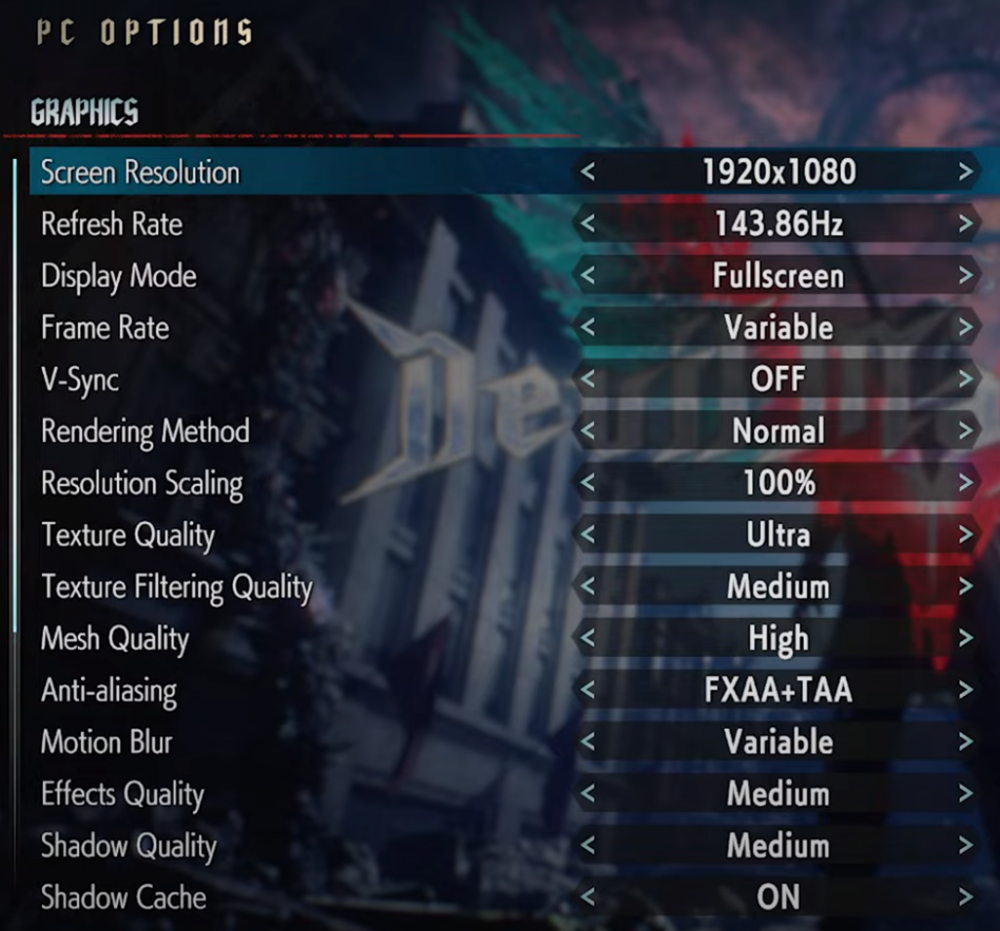
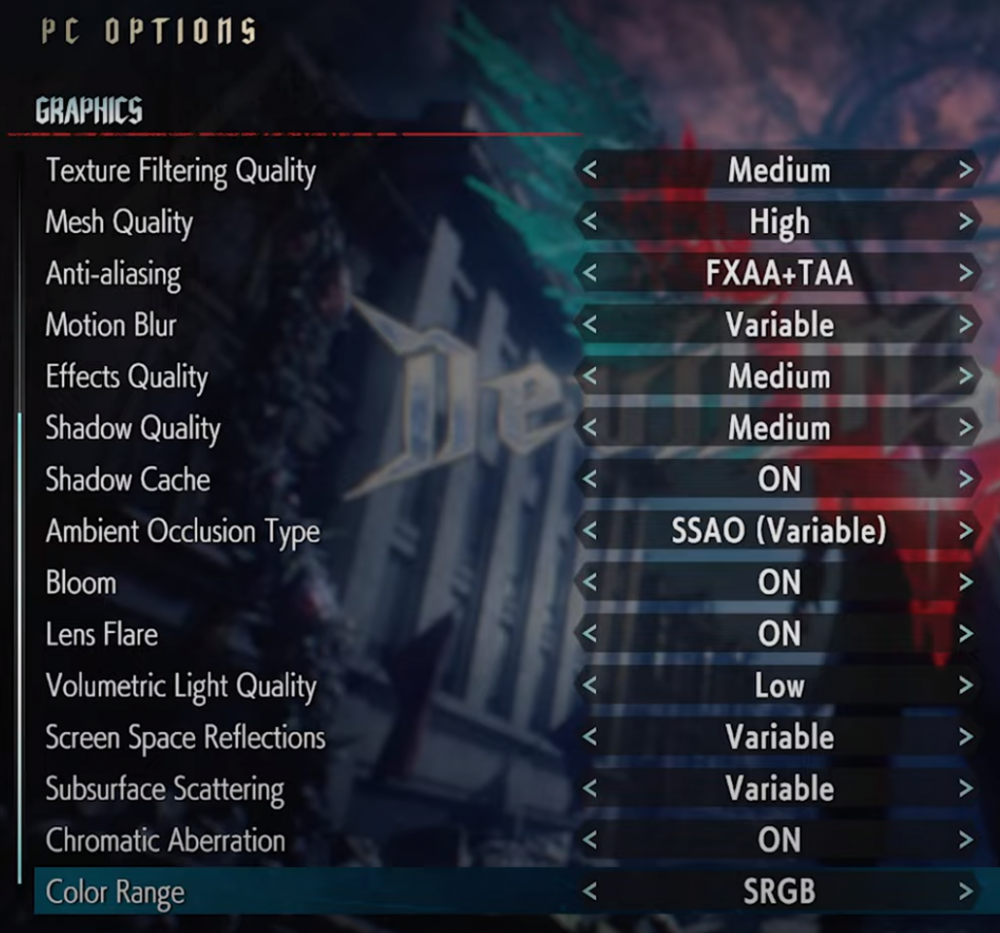
We can see the following FPS results from the benchmark they ran.
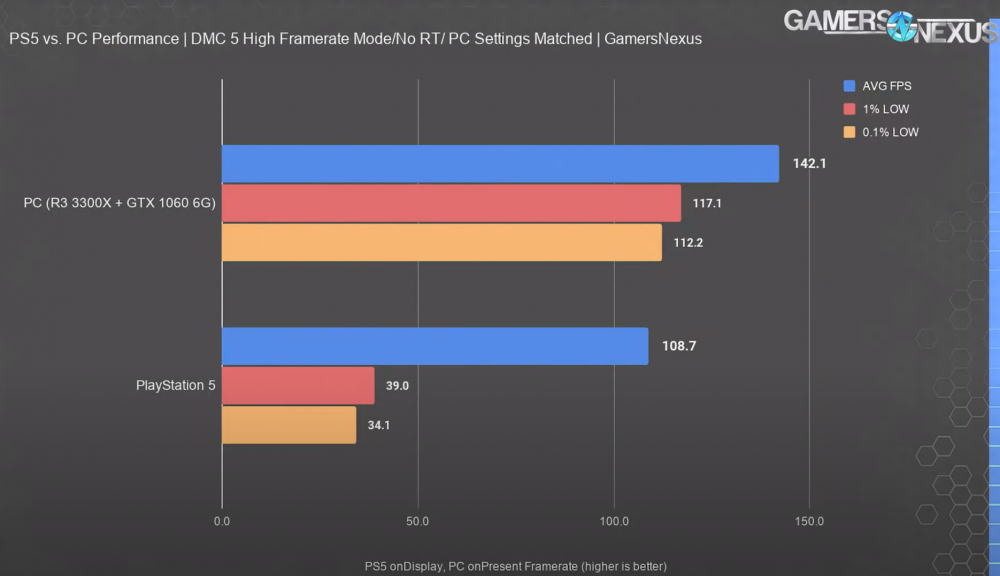
Apart from the higher frame rates from the PC, the discrepancy between the average and the lows are much smaller on PC than on PS5. This is also good news for the PC.
Something not as commonly spoken about is the frametime. In fairly simple terms, frametime tells you how long each frame takes to render. As for why this metric matters, to give an extreme example: say your GPU takes 0.9 seconds to render a single frame, then it quickly goes on to render 59 frames in 0.1 seconds. You’d perceive a very bad stutter, yet the FPS reading would still be able to stay at 60FPS. With frametime, essentially, what you want to see is consistency, and lower numbers. So here’s what GN found.
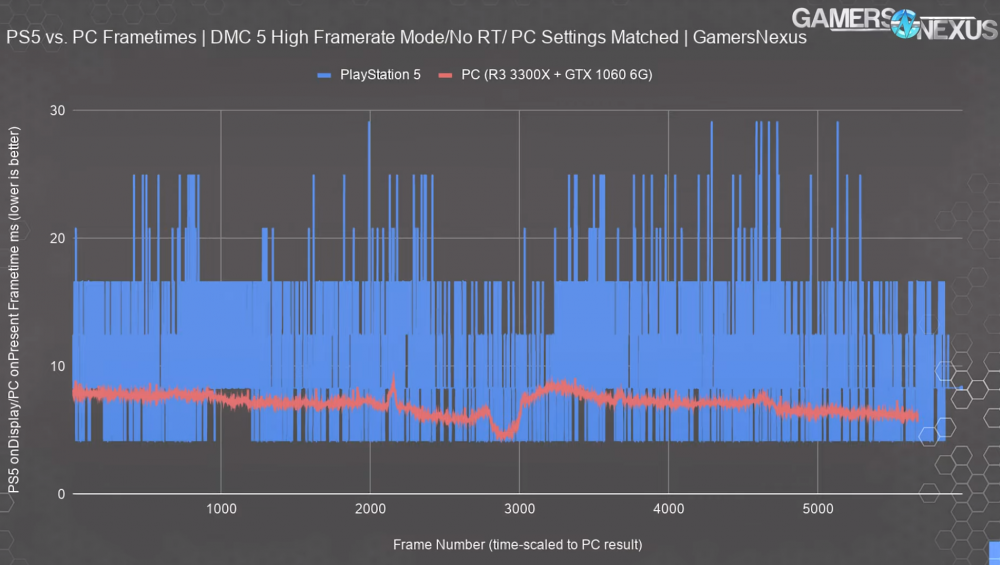
DiRT 5
Although the benchmark will show the PC performed less favourably in terms of raw FPS, GN did comment that despite the settings on PC, the cars appeared shinier on PC, and more defined reflections of individual light sources, as well as the PS5 in 120FPS never having any spectators. It goes without saying that none of this is a precise direct comparison, but certainly this amplifies that.
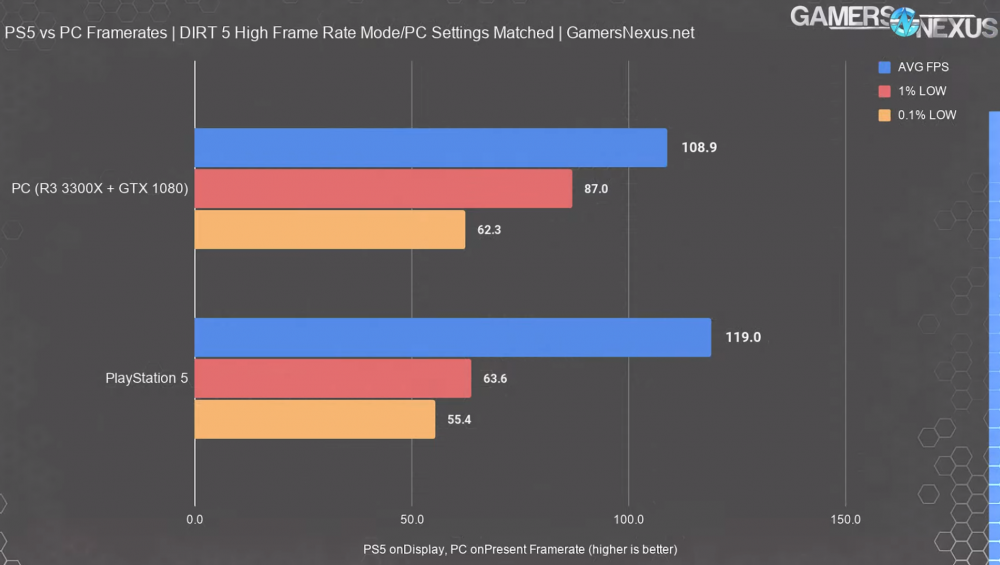
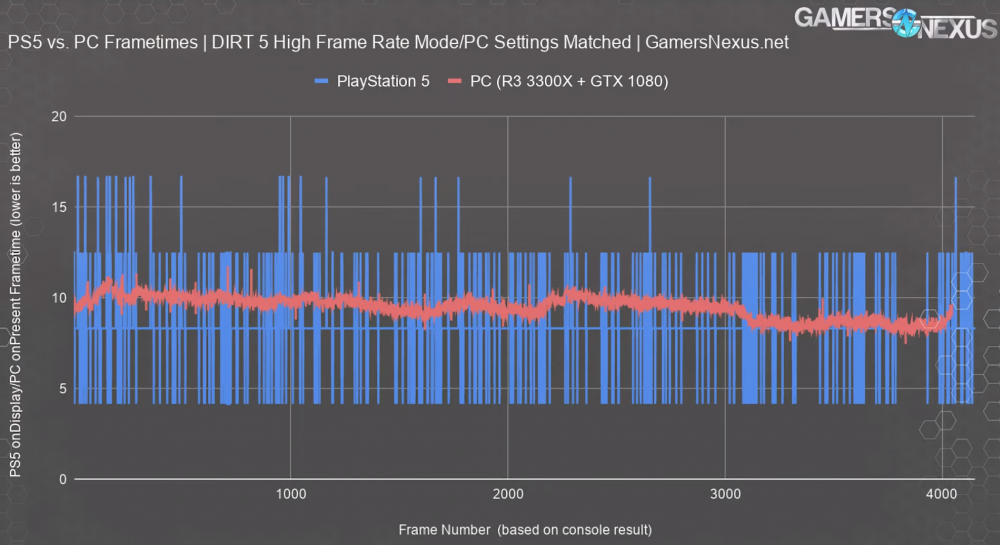
The frametime is once again more consistent on PC.
Borderlands 3
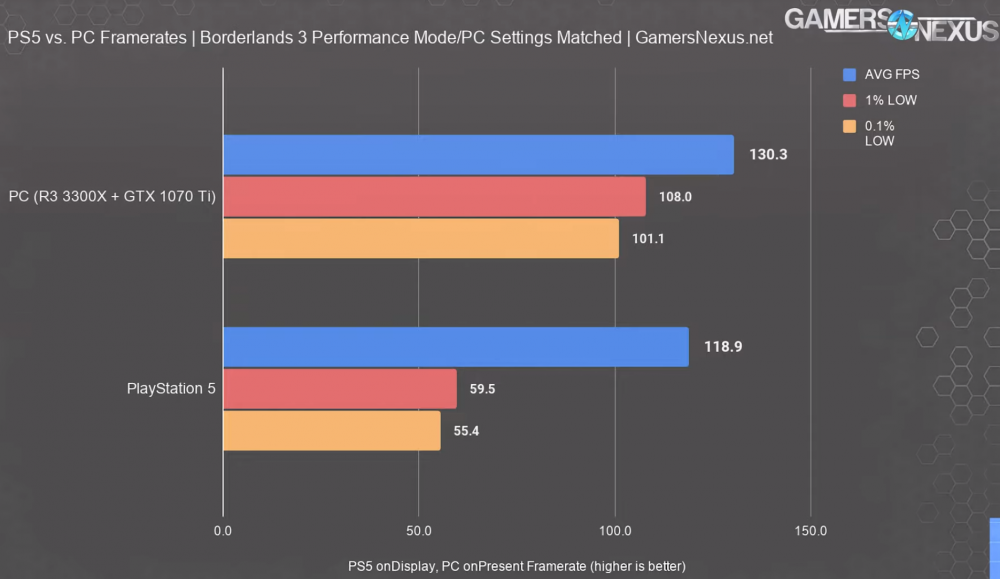
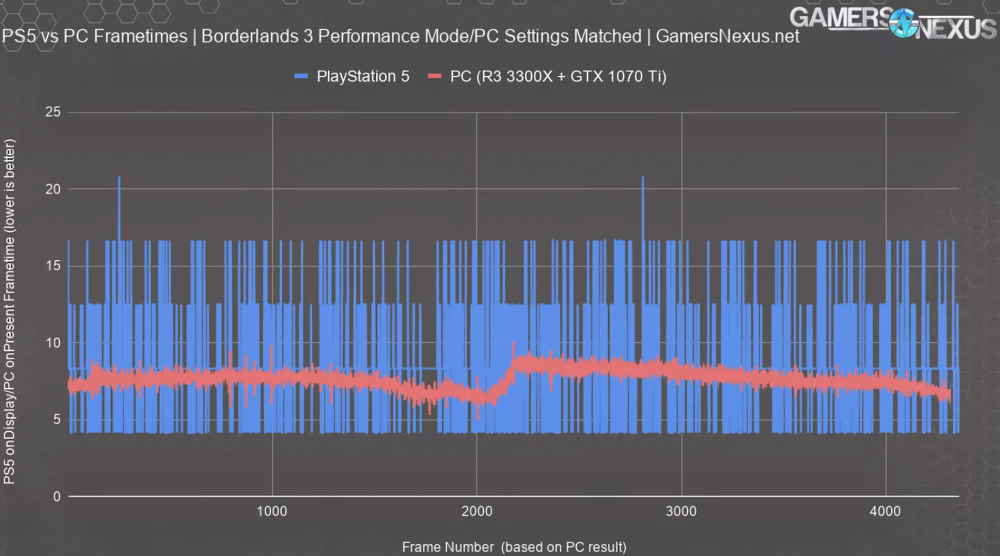
Conclusion
Steve expresses his dislike for “performance per dollar” type of comparisons, especially when comparing quite unlike products such as a gaming console to a gaming PC, as a PC can also serve other purposes, such as work related, whereas a gaming console is much more straightforward in that it basically only has one purpose.
It’s clear that the PS5 is quite good in these limited tests, but keep in mind that all this testing was done at a 1080p resolution, meaning we’re not exploring the 4K aspect of things and are instead focussed on the 1080p (which pretty much every display in your life these days should be at minimum) at high frame rate (which may not be in every display) up to 120 FPS.
Steve, in his conclusion, states that the PS5 is roughly where PC hardware/performance was about 5 years ago.
To give you an idea of how a GTX 1080 (which was the highest performing GPU Steve from Gamers Nexus used in these tests) performs verses currently available graphics cards, you can see the chart below.
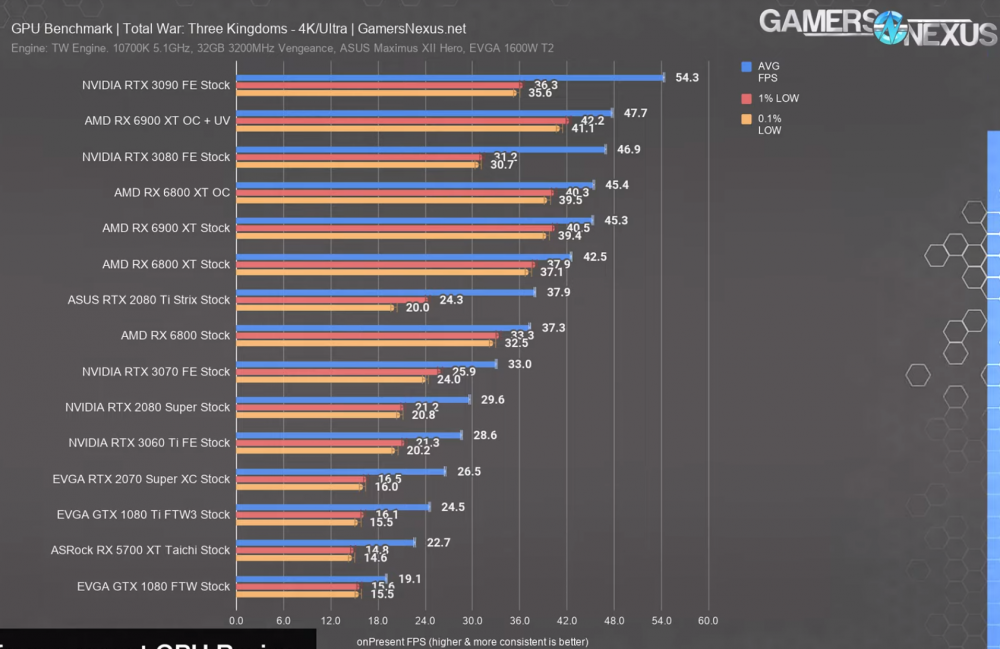
Likewise, for the CPU we can offer the same type of information.

Assuming you were after the most cost effective PC from us that hit those targets, this would be that PC. Remembering that consoles generally sell at a loss, and the manufacturers usually rely on their customers purchasing games and subscriptions over the lifespan of the console to recoup their costs, as well as claim market share. Also of course that a gaming PC is also a PC, and can be upgraded over time to improve performance/features. Also, the PC linked above is considerably better performing than the benchmarks shown earlier on in this post!
To sum up, the PS5 should be fine for a casual gaming experience as it is quite cost effective compared to buying brand new PCs which also have a warranty. However, if you’re interested in doing more than just playing games, such as streaming or doing work, or playing games at truly impressive graphics quality + high frame rate & maybe even ray tracing, then the PC is still champion.
If you’re in the market for a gaming PC, checkout what we have on offer!
